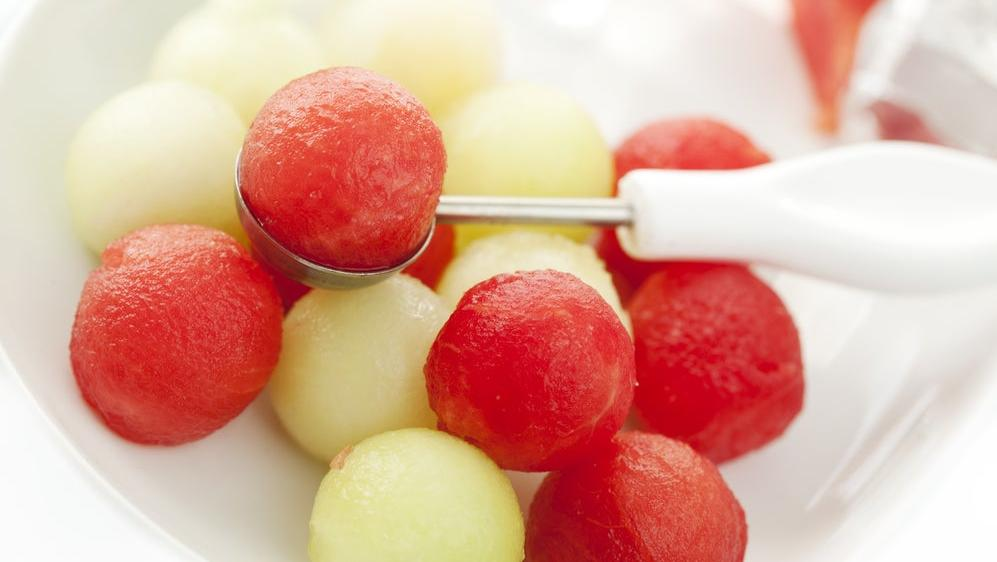A Casual Grocery Store Guide To Melons
Maximize summer enjoyment with knowledge of summer’s signature fruit.
Generally, I regard any form of melon as a filler fruit. They're often bland, with faded colors, packed in a fruit salad with some slimy grapes and a brown banana slice or two, or offered as a side at brunch instead of potatoes for people who want to feel virtuous while eating a sky-high mound of waffles. However, if you've ever had a juicy, fresh melon, you know a good melon is one of the most refreshing foods on a hot summer day. Paired with any number of savory and sweet accouterments, melon can really elevate the tone of a summer dinner or cocktail party. But knowing which melon is which, and how to find a good one at the grocery store, is not always intuitive. Let the following list be your guide.
Watermelon
"Down by the baaaay/ Where the watermelons grooooww..." Summertime is when you break out the watermelon. Everyone knows this. A watermelon wearing sunglasses is the mascot of summertime. Watermelon is great on its own, mixed into a salad with mint and feta, or transformed into something else, like this burger. Once at a vegan restaurant in New York City, I had watermelon in place of ahi in a sushi-inspired meal that was, honestly, phenomenal.
My children, along with most other children, will only eat seedless watermelon, but don't worry if you get one with seeds. While my favorite maternity shirt had a picture of a watermelon along with the caption "I swallowed a seed," you will not, in fact, grow a watermelon if you eat the seeds. If your kids can't be convinced to eat the seeds, you can always blend up the watermelon for alternative uses and strain out any seeds that haven't been fully pulverized.
To tell if a watermelon's good before buying it, look for a light-colored spot where it rested on the ground and check that there's no give anywhere on the surface. Give it a little tap for fun and then convince yourself it sounded nice.
Honeydew
Named for Dr. Bunsen Honeydew of the Muppets (I wish), honeydew is ubiquitous in fruit salads sold in gas stations. It's the most offensive filler fruit when it's bad—every bite tastes like a watermelon rind—but good honeydew is mild and even surprisingly creamy. It's a delicious summer fruit, or at least I've always thought so; in my polling, it turned out to be one of the more divisive fruits in the produce section.
Like its namesake Dr. Honeydew's skull, the fruit has a light, textured exterior and usually a slight green flesh, though it can also be white or yellow. Due to its many vitamins and minerals, honeydew is good for a dewy complexion, strong bones, and a strong immune system.
To find a good honeydew, you'll have to do some lifting—it should feel deceptively heavy when you pick it up. It's often used as-is in salads, smoothies, or drinks, but it can also become a more complex flavor in a cucumber salad.
Cantaloupe
This is the orange-colored melon in the same aforementioned gas station cup of fruit salad. With its signature "netted" exterior, the cantaloupe has a stronger flavor and, unlike honeydew and watermelon, a rather dense texture, more like a mango than a watermelon. The orange color, like in carrots, is from beta-carotene, so, like carrots, eating enough cantaloupe can help you see in the dark and, theoretically, turn you orange (remember all those vitamin truths we were taught as kids?).
To pick a good one, make sure the color behind the "netting" on the rind is more beige than green. You can also give it a sniff to see if it's giving off the lightly fruity scent that it ought to, and press a finger firmly into the indent left behind by the stem—if it's firm but not hard, you have a winner.
Your elders may have eaten a breakfast of cantaloupe filled with cottage cheese from time to time, but cantaloupe is very versatile and can make an appearance in many seasonal recipes. Pair it with prosciutto for a classy appetizer.
Lesser-known melons
Here are some melons that, depending on where you live, you might find in your local grocery store, but not often and only if you're lucky:
- Casaba: Another melon that looks like a squash or decorative gourd, the acorn-shaped casaba has a mild, slightly spicy flavor, often good in savory dishes or as a sidekick in sweet smoothies. Unlike many melon varieties, these grow best in hot, dry climates.
- Persian: These are described as having a "musky" scent, but a cantaloupe-like flavor. They're long and unridged, with a very green interior.
- Crenshaw: These lesser-known but widely available melons are yellow on the outside, with a thick, squash-like rind. They're a cross between casaba and Persian melons, described as slightly sweet, floral, or sometimes vegetal. Its uses are virtually interchangeable with those of cantaloupe.
- Galia: This is a cantaloupe-honeydew hybrid, created in a lab in the '70s. Like cantaloupe, it has a "netted" rind, but like honeydew, it has slightly dense green flesh. These Frankenstein monsters are grown around the world; in the United States, the crops are most successful in the climate of the South.
- Canary: This appropriately bright yellow winter melon is sweet like honeydew, but tangier. It's frequently found across Asia.
While there seem to be infinite types of melon in the world, I challenge you to find anything beyond watermelon, cantaloupe, and honeydew in your everyday market, then use your melon to come up with a creative use for it. Give it a whirl—you might just create the antidote to sad gas station fruit salad.
